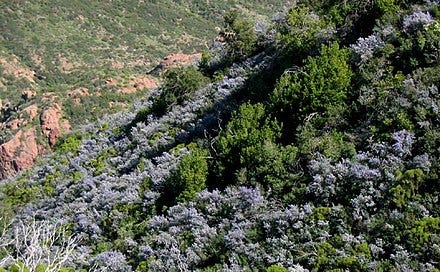New science finds hope in remedying threats to Southwestern ecosystems
Looking for answers to type conversion
Before I start on today’s topic, I want to thank all the new subscribers who have signed up for The Green Dispatch this past month. I always like to hear new perspectives, so please don’t be shy about making comments. And for all you folks who have been around for a while—some of you go back to the very beginning—thanks, too. I appreciate all of you and all that you have to say. Don’t hesitate to let me know what you think by clicking on the comment bar. We’re well into our second year. I hope things have remained interesting, informative, and sometimes fun.
One of the great joys of living in southern California is hiking among chaparral, oak woodlands and pine forests. Many of these wildlands have nonetheless changed, and many more are changing still. Some pine forests have turned or are turning into shrubland, and chaparral is being converted to landscapes of nonnative grasses.
This phenomenon in which one plant community or biome is converted to another is called “type conversion” and is caused by stresses to the environment, such as climate change and the introduction of nonnative species. In the forests of the western United States, many of these changes have come about because we’ve suppressed fires for the last hundred years or so, resulting in overcrowded forests; in other cases fires have occurred too often, burning trees or chaparral before they fully mature and allowing shrubs or grasses to take over.
In southern California where I live, the most common, natural plant community is chaparral. Chaparral is beautiful. Composed of evergreen shrubs and trees, chaparral keeps the mountainsides and valleys of California green all year long. In spring, the blooms of the ceanothus paint landscapes with touches of azure. Hillsides can be dominated by gnarly and rust colored manzanita. But a great deal of the chaparral has been type converted into nonnative grassland. It’s something that’s ugly, but after a while, you get used to seeing grass covered hillsides or spotting places where grass is taking over.


New examination on type conversion management (or non-management)
Scientists have understood about type conversion and its causes, but not much is known about stopping it or recovering landscapes once they have been converted. To find ways of managing or stopping these conversions of biomes a research team gathered and met with with scientists and wildlands managers from California, Arizona, New Mexico, and Colorado to hear their experiences with conversion and their responses and outcomes. The results of these meetings were published in the journal Fire Ecology in May of this year.
The researchers found that there is almost zilch known about fighting or reversing type conversion. As the authors of the paper say, measures to mitigate type conversion are often “trial-and-error approaches devised after the fact.”
In many cases land mangers simply monitored the changes without doing anything to mitigate or forestall the advance. This hands-off approach is the strategy (or lack thereof) of the land managers at Lassen National Park in northern California. Lassen is one of the most beautiful and dramatic (and least visited) national parks and, with the geologically activity of geysers and sulfurous hot pots, one of the more interesting. The park has, unfortunately, also experienced heavy fires that transformed mixed conifer forests into shrublands. So far, the managers there are keeping an eye on the changes but are not trying to forestall them.
There were a good number of unsuccess stories. Almost 19 years ago, the Cedar Fire ripped through the eastern portion of San Diego County, charring 273,246 acres. After the fire, much of the pine forests were naturally revegetated by ceanothus, a native shrub that grows to about six feet. Within a few years, land managers tried to reestablish the Jeffrey pine forests in the Laguna Mountains that were burned in the fire. Those efforts proved to be a complete failure, as years of drought ensured that no Jeffery pines, whether planted or naturally sprouting, survived. What has grown back are the ceanothus and other shrubs, as well as herblands, interrupted by only the occasional black oak or Coulter pine. Within the last ten years, the introduced gold spotted oak borer, an invasive pest, killed most mature oaks in the region, further complicating recovery efforts.
On the other hand, the researchers found some encouraging news. In 2002, in the eastern Front Range of the Rockies, Colorado experienced the largest fire up to that date in its history. The Hayman Fire consumed 138,114 acres. Unlike the experience in the Laguna Mountains, the Colorado land managers achieved a relatively high rate of success in planting seedlings of Douglas fir and ponderosa pines. They credit their success to planting early in the spring at sites that promised to be the most productive and using coarse, woody debris and other objects to shade the seedlings.
The authors of the paper see type conversion potentially affecting larger and larger areas, as wildfires have grown larger and more numerous. Yet they found that simple measures like planting at the right time of year and shading seedlings can prove effective in landscape recovery. With further research, they see a great deal of promise in our ability to not only stave off type conversion but to reverse it in many environments.
For more environmental science & news follow me on Twitter @EcoScripsit.




